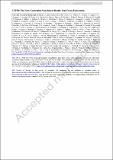| dc.contributor.author | Alfonso, K. | |
| dc.contributor.author | Armatol, A. | |
| dc.contributor.author | Augier, C. | |
| dc.contributor.author | Avignone, F. T. | |
| dc.contributor.author | Azzolini, O. | |
| dc.contributor.author | Balata, M. | |
| dc.contributor.author | Barabash, A. S. | |
| dc.contributor.author | Bari, G. | |
| dc.contributor.author | Barresi, A. | |
| dc.contributor.author | Baudin, D. | |
| dc.contributor.author | Bellini, F. | |
| dc.contributor.author | Benato, G. | |
| dc.contributor.author | Beretta, M. | |
| dc.contributor.author | Bettelli, M. | |
| dc.contributor.author | Biassoni, M. | |
| dc.date.accessioned | 2023-06-20T17:44:20Z | |
| dc.date.available | 2023-06-20T17:44:20Z | |
| dc.date.issued | 2022-11-29 | |
| dc.identifier.uri | https://hdl.handle.net/1721.1/150918 | |
| dc.description.abstract | Abstract
CUPID is a next-generation tonne-scale bolometric neutrinoless double beta decay experiment that will probe the Majorana nature of neutrinos and discover lepton number violation in case of observation of this singular process. CUPID will be built on experience, expertise and lessons learned in CUORE and will be installed in the current CUORE infra-structure in the Gran Sasso underground laboratory. The CUPID detector technology, successfully tested in the CUPID-Mo experiment, is based on scintillating bolometers of Li
$$_2$$
2
MoO
$$_4$$
4
enriched in the isotope of interest
$$^{100}$$
100
Mo. In order to achieve its ambitious science goals, the CUPID collaboration aims to reduce the backgrounds in the region of interest by a factor 100 with respect to CUORE. This performance will be achieved by introducing the high efficient
$$\alpha$$
α
/
$$\beta$$
β
discrimination demonstrated by the CUPID-0 and CUPID-Mo experiments, and using a high transition energy double beta decay nucleus such as
$$^{100}$$
100
Mo to minimize the impact of the gamma background. CUPID will consist of about 1500 hybrid heat-light detectors for a total isotope mass of 250 kg. The CUPID scientific reach is supported by a detailed and safe background model based on CUORE, CUPID-Mo and CUPID-0 results. The required performances have already been demonstrated and will be presented. | en_US |
| dc.publisher | Springer US | en_US |
| dc.relation.isversionof | https://doi.org/10.1007/s10909-022-02909-3 | en_US |
| dc.rights | Article is made available in accordance with the publisher's policy and may be subject to US copyright law. Please refer to the publisher's site for terms of use. | en_US |
| dc.source | Springer US | en_US |
| dc.title | CUPID: The Next-Generation Neutrinoless Double Beta Decay Experiment | en_US |
| dc.type | Article | en_US |
| dc.identifier.citation | Alfonso, K., Armatol, A., Augier, C., Avignone, F. T., Azzolini, O. et al. 2022. "CUPID: The Next-Generation Neutrinoless Double Beta Decay Experiment." | |
| dc.contributor.department | Massachusetts Institute of Technology. Department of Physics | |
| dc.eprint.version | Author's final manuscript | en_US |
| dc.type.uri | http://purl.org/eprint/type/JournalArticle | en_US |
| eprint.status | http://purl.org/eprint/status/PeerReviewed | en_US |
| dc.date.updated | 2023-06-17T03:22:42Z | |
| dc.language.rfc3066 | en | |
| dc.rights.holder | The Author(s), under exclusive licence to Springer Science+Business Media, LLC, part of Springer Nature | |
| dspace.embargo.terms | Y | |
| dspace.date.submission | 2023-06-17T03:22:42Z | |
| mit.license | PUBLISHER_POLICY | |
| mit.metadata.status | Authority Work and Publication Information Needed | en_US |
